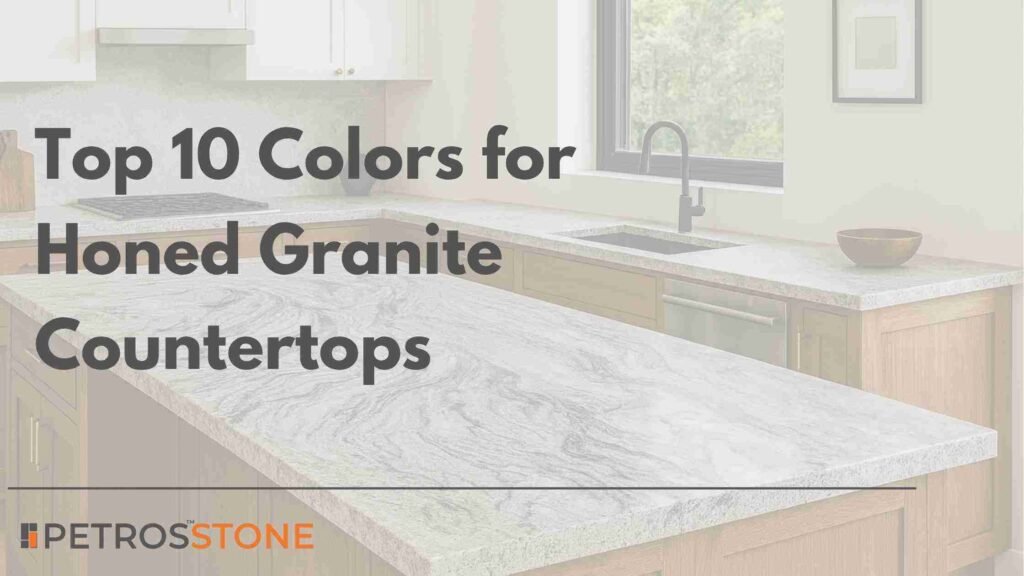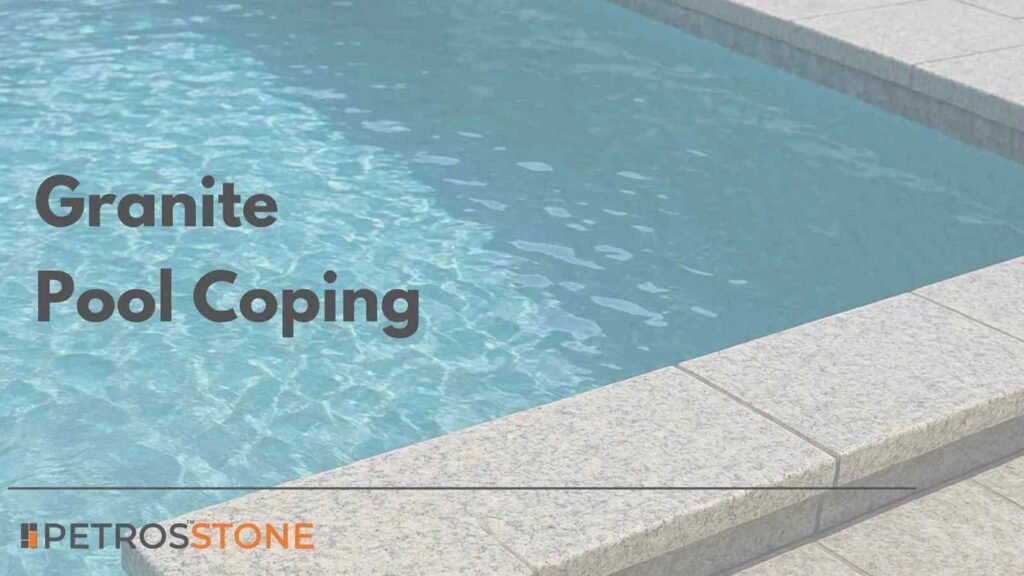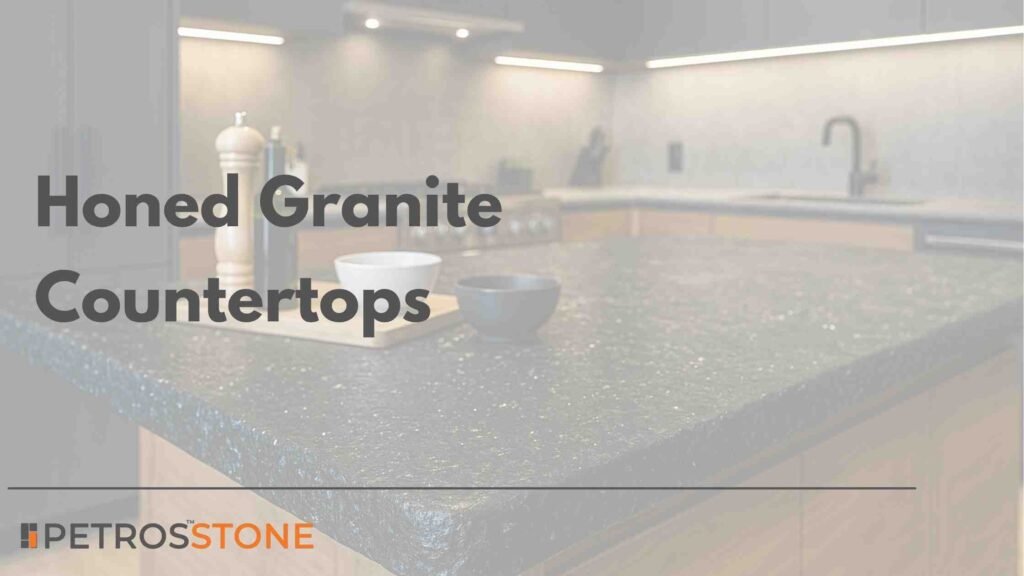Luxurious, lustrous and much-loved, marble continues to be one of the most preferred flooring and countertop choices for all types of interiors. The elegant natural stone is primarily classified into Italian marble, quarried from Northern Italy, and Indian marble quarried from the Indian state of Rajasthan. The question is, which is better between Indian vs Italian marble.
The main difference between Indian vs Italian marble, apart from their sources of origin, lies in their lustre and hardness. While Italian marble comes with a high lustre and soft crystal-like appearance, Indian marble offers medium lustre and comparatively more hardness.
To learn about the Best Italian Marbles for Flooring, read our article : 20 Best Italian Marbles for Flooring
In this comprehensive article, Petros will guide you through some of the major points of difference between Indian and Italian Marble, so that you can make a more well-informed choice.
- Indian vs Italian Marble
- Shortcomings of using Indian and Italian Marble for Interiors
- Why Marble Interiors Never go out of Trend
- Trending Ideas to use Marble for Interiors
- Indian vs Italian Marble: Our Pick?
- Points to Keep in Mind – Picking between Indian & Italian marble
- The Final Verdict
- Best Place for Indian and Italian Marble
Without any further ado, let us dive straight into the beauty and luxury of marble for the most stylish interiors.
Indian vs Italian Marble
When it comes to choosing between Indian and Italian Marble, there are quite a few factors of difference – from appearance to strength to finishes and more. It is best to refer to industry experts and professionals for accurate information about the key differences and comparative advantages when it comes to Indian vs Italian Marble.
here we have consolidated a comprehensive overview of the differences between Indian and Italian Marble:
Comparison table: Indian vs Italian Marble | Differences
| Parameter | Indian Marble | Italian Marble |
| Source | Quarried from Indian states of Rajasthan, Gujarat, Andhra Pradesh and Madhya Pradesh | Quarried from Northern Italy |
| Lustre | Medium lustre, not much sheen | High lustre, very glossy surface |
| Colours | White, Grey, Deep Yellow, Green, Red, Black, and more | White, Grey, Blue-Grey, Rose, Green, and more. |
| Softness | Harder, less susceptible to damage | Softer, more brittle and susceptible to chips & cracks |
| Thickness | Usually, 15-20 mm | Usually, 18 to 20 mm |
| Durability | Harder and heavier, hence more durable and long-lasting | Brittle and soft, requires nylon sheet backing or extra reinforcement with epoxy resins and gluing of hard stone on edges |
| Types | Makrana, Ambaji, Indian Statuario, Jodhpur Pink. Onyx | Statuario, Golden Botticino, Cararra, Nero Marquina, Perlato Sicilia, Rossa Verona, Crema Marfil |
| Polishing | Available in both polished and unpolished varieties | Available as one-side polished slabs |
| Laying | Requires lesser level of skills or experience for laying out, and hence lower labour charges | Requires high-quality, experienced craftsmen for perfect laying; time-taking process |
| Environmental Concerns | No toxins or chemicals used in extraction, reinforcement or application of Indian marble | Requires strengthening using nylon backing and treatment with epoxy resins, which are toxic chemicals for the environment. |
| Applications | Flooring, walls, countertops | Flooring, walls, decorative features, backsplashes |
| Costs | Starts at INR 80 per square foot. Laying charges around INR 10 to 300 per square foot | Starts at INR 350 per square foot. Laying charges around INR 10 to 300 per square foot. |
Place of Origin
Indian Marble, as the name suggests, originates in India. The natural stone is quarried from various locations in the states of Rajasthan, Gujarat, Andhra Pradesh and Madhya Pradesh, and also from other locations. On the contrary, Italian Marble owes its roots to quarries in northern Italy.
The difference in source and origin of the two marble surfaces dictates, therefore, its costs as well. Indian marble would cost much less when it comes to transportation, for it will only need to traverse a few states. Italian marble, on the other hand, needs to be imported from across country borders. This is why it costs much higher compared to its Indian counterpart.
Therefore, between Indian vs Italian marble, the source of origin and extent of transportation involved renders high the price and hassle of Italian marble. This is why Indian marble is usually the type of choice for people on a budget.
Lustre
When it comes to picking between Indian vs Italian Marble in terms of sheen and lustre, the Italian counterpart wins the bet. It boasts of an extremely high-quality lustre that offers a pearly, luminescent appearance. On the other hand, Indian Marble offers a medium lustre, which might not come across as glossy as its Italian counterpart.
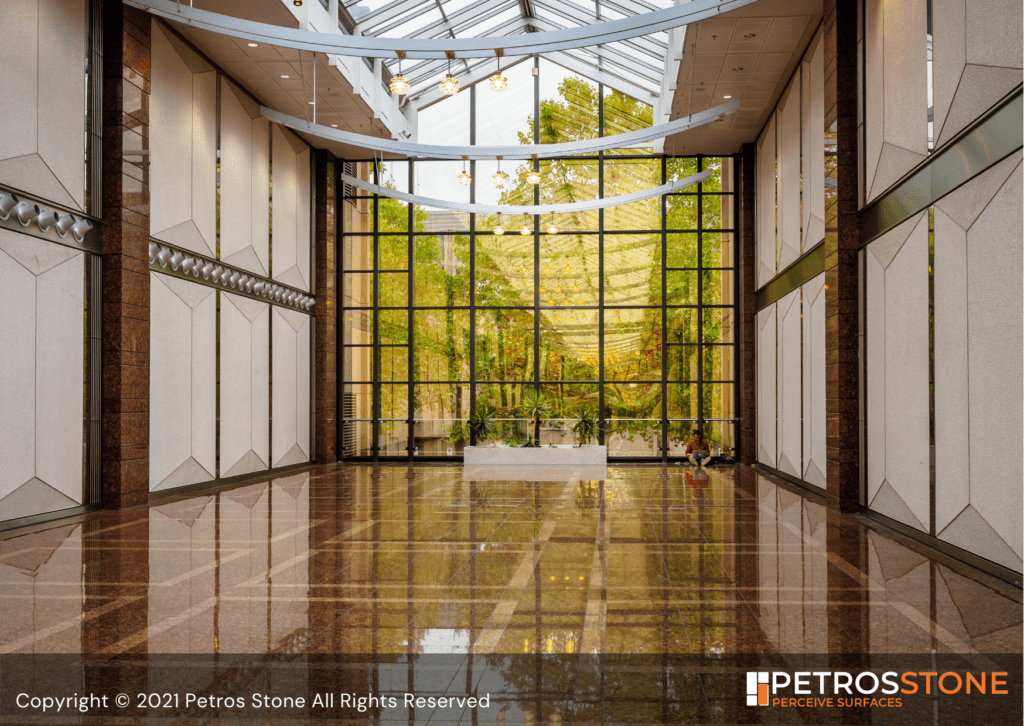
While this lustre might not be as important a decision-maker when using marble in homes, it certainly has a pronounced impact when it comes to public or commercial establishments. No other stone surface matches up to the unique combination of high lustre and unique organic veins of Italian marble. Therefore, using Italian marble for flooring in spaces adds to their grandness and is sure to make heads turn.
Colours
The range of colours that both Indian and Italian marbles are available in is quite impressive, to say the least. Italian Marble stands out with a magnificent collection in White, Grey, Blue-Grey, Rose, Green and more. On the other hand, Indian Marble is available in grand palettes of White, Grey, Deep Yellow, Green, Red, Black and more.

Both Indian and Italian marbles display an exotic variation when it comes to colours. Futher, these colours have plenty of sub-shades and tones to offer within the same head. To say the least, you will always find something to make a statement with these gorgeous natural stones.
Such a wide variety of colours also means that it is easy to pick a marble surface that will go with a predetermined style. You can always pick out your furniture first, which is much tougher to choose based on your dream vision; you will always get a flooring of choice to go with the walls and furniture when it comes to marble.
Softness
Compared to Indian Marble, Italian Marble is comparatively very soft and brittle. It can develop small hairline cracks with time even with regular, not too heavy use. Its Indian counterpart is not just harder but also less susceptible to accidental damage. This is a clear point of difference between Indian vs Italian marble, and a deciding factor when it comes to choosing which to use where.
You should make sure not to use Italian marble for flooring in spaces that are to see high traffic or movement of heavy items, such as in stores or movie halls. Indian marble would be a better choice if you are certain you want to use marble alone. Otherwise, high resistance stone surfaces such as Petros® Italian Quartz would be a far greater choice.
When it comes to wall accents, or flooring and countertops without heavy duty, Italian marble can be a great choice. However, Indian marble can prove to be the wiser decision if you want maximum life with lesser maintenance and care comparatively.
Thickness
Both Indian and Italian marbles are available in a wide range of thicknesses. Italian marble usually varies between 18 to 20 mm in thickness, while Indian marble is usually 15-20 mm thick. The difference in thickness dictates the application of the stone as well.
The difference in thickness between Indian vs Italian marble also leads to difference in their transportation means and costs. Italian marble comes across as a little more fragile, and needs special attention and care throughout. It also requires external reinforcements to keep it safe, compared to Indian marble which does not require such nitty-gritties.
Durability
Italian marble being much softer compared to its Indian counterpart, it is less durable comparatively as well. This kind of marble requires some extra reinforcement, such as thin nylon sheets or nets on the back side for added durability against regular wear and tear.
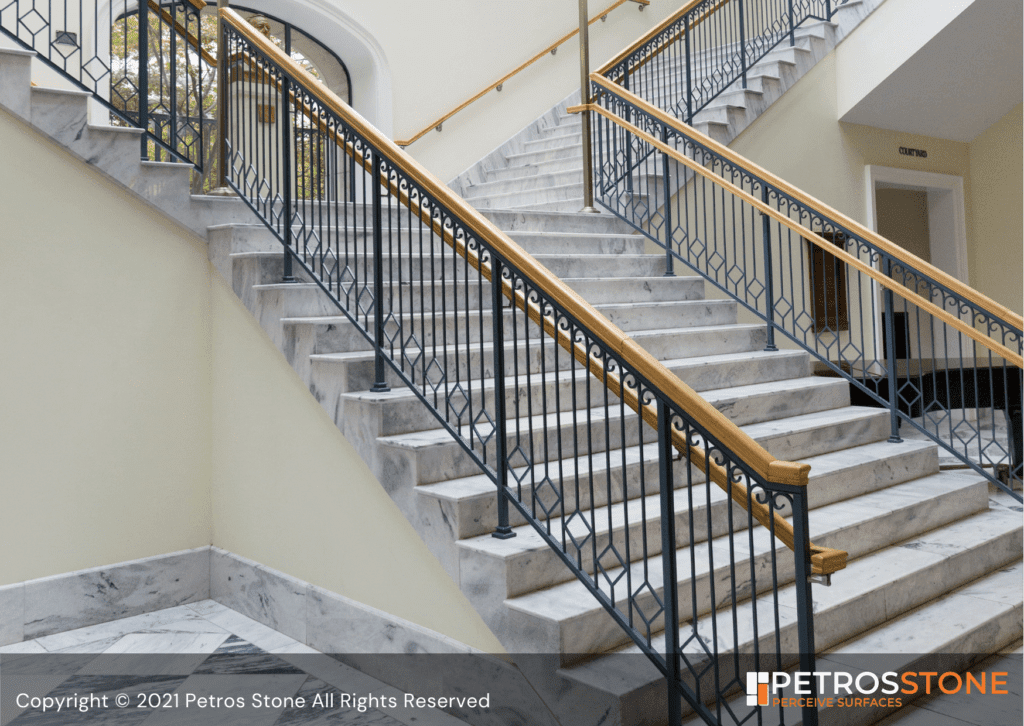
Italian marble also needs to be treated with epoxy resins, with additional pigments in matching colours for greater strengthening. Hard stone may be glued on its edges to prevent stone slabs from crumbling or chipping during transportation or rough handling.
Types
Though there are many varieties in which both Indian and Italian marble are available, a few are considered the most popular out of all. Indian marble comes in types such as the lustrous white Makrana marble, which has been famously used in the Taj Mahal, or the superior quality Ambaji marble that owes its roots to Gujarat.
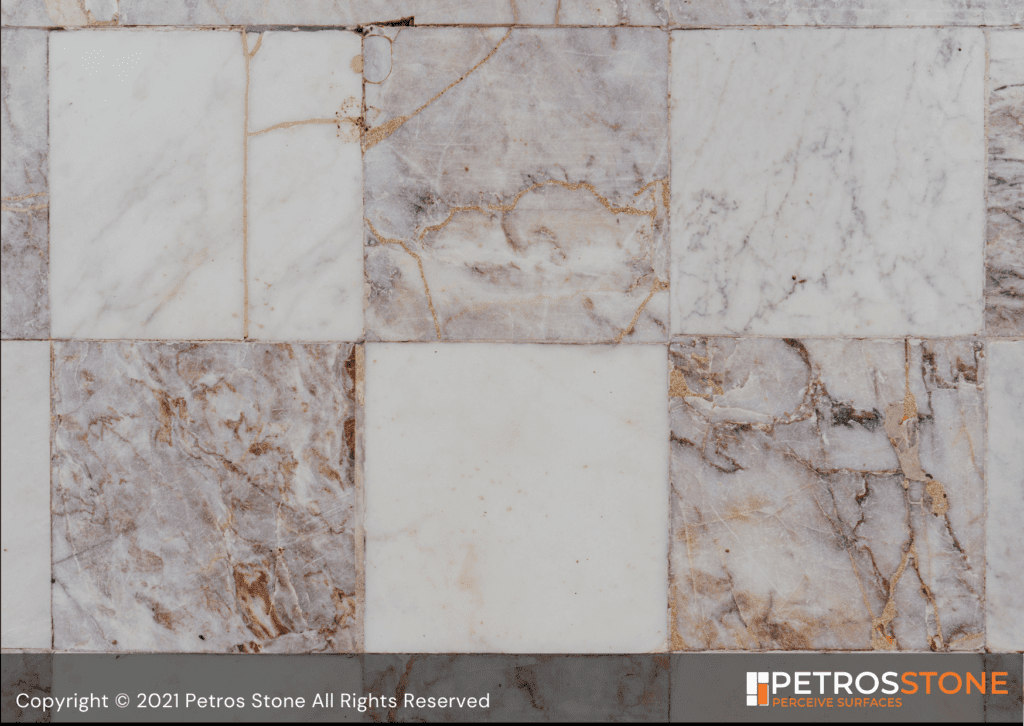
Similarly, the widely popular Indian green marble, the White Indian Statuario marble, the Jodhpur pink marble and the Onyx marble are all different varieties of Indian marble that you should know about.
When it comes to the Italian counterpart, the much-valued Statuario marble is a fine example, as is the golden Botticino or the light grey Carrara variation which is known for its characteristic veination,. The Nero (black) Marquina is yet another example to behold, as is Perlato Sicilia, Rossa Verona and Crema Marfil.
Polishing
India marble is available in both polished and unpolished varieties, thus suiting an array of different requirements for different spaces. On the other hand, Italian marble is available only as one-side polished slabs, as it has a nylon backing for extra reinforcement.
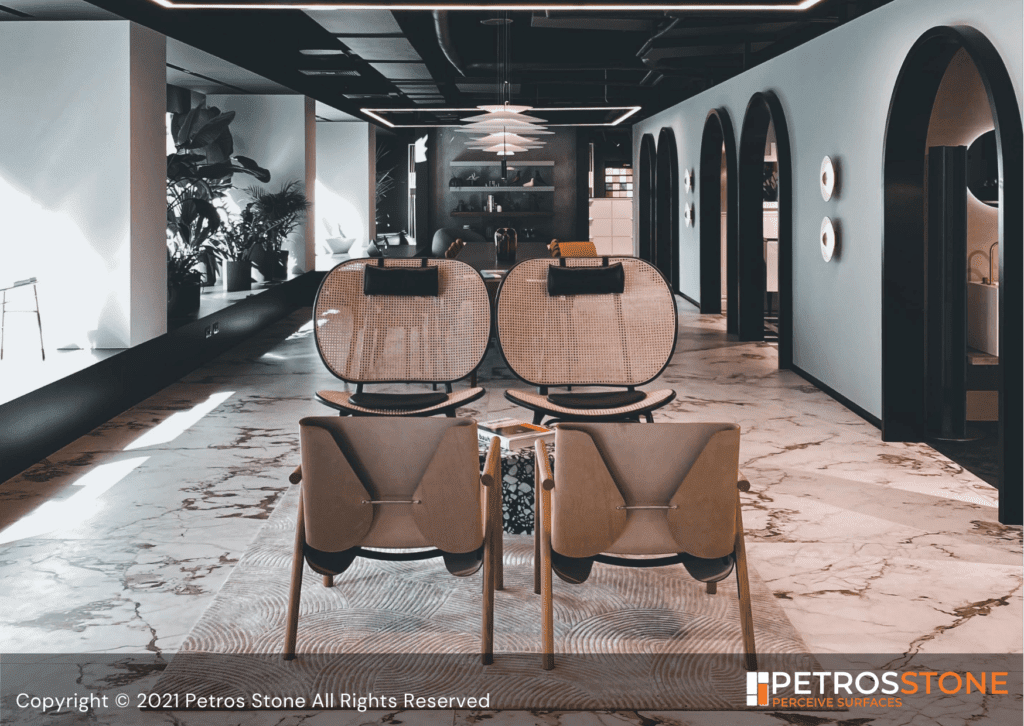
This pronounced difference between Indian vs Italian marble usually dictates their adoption for various kinds of needs. For instance, since Indian marble is available as both polished and unpolished slabs, one can install the slabs first and polish it only after it has settled properly, without having to worry about any scratches or discrepancies in the process. With the already polished Italian marble, however, it can become difficult to lay down the marble slabs if you do not have expert assistance.
Laying
Italian marble demands high-quality and experienced craftsmen for a perfect laying of the stone. At the same time, its laying process is more tedious and time-taking. The slabs are usually not polished on one side, besides being much thinner comparatively, and much more susceptible to damage during the installation process due to inherent softness.
Indian marble, on the other hand, requires comparatively lesser level of skills. You neither have to fret over high labour charges, not for finding the specific person to deal with the stone. This kind of marble surface is comparatively harder, and not as prone to scratches and abrasion as its Italian counterpart. Therefore, it does not need as much expert supervision as compared to Italian marble.
Environmental concerns
Italian marble is known to be brittle and softer compared to Indian marble. This is the reason it has to strengthened using a nylon backing, while also being treated with epoxy resins, matching pigments and chemical resin sealers. These toxic elements create a potentially harmful outcome for the environment.
On the other hand, no toxins or chemicals are used in the extraction, reinforcement or application of Indian marble. This is another reason people prefer using Indian marble for their projects instead of its Italian counterpart.
Applications
When it comes to the right spaces to use Indian vs Italian marble, the weight of the two plays a key part. Indian marble, being heavier and sturdier, is more useful as flooring, and for walls and countertops in kitchens and bathrooms besides using as tabletops.
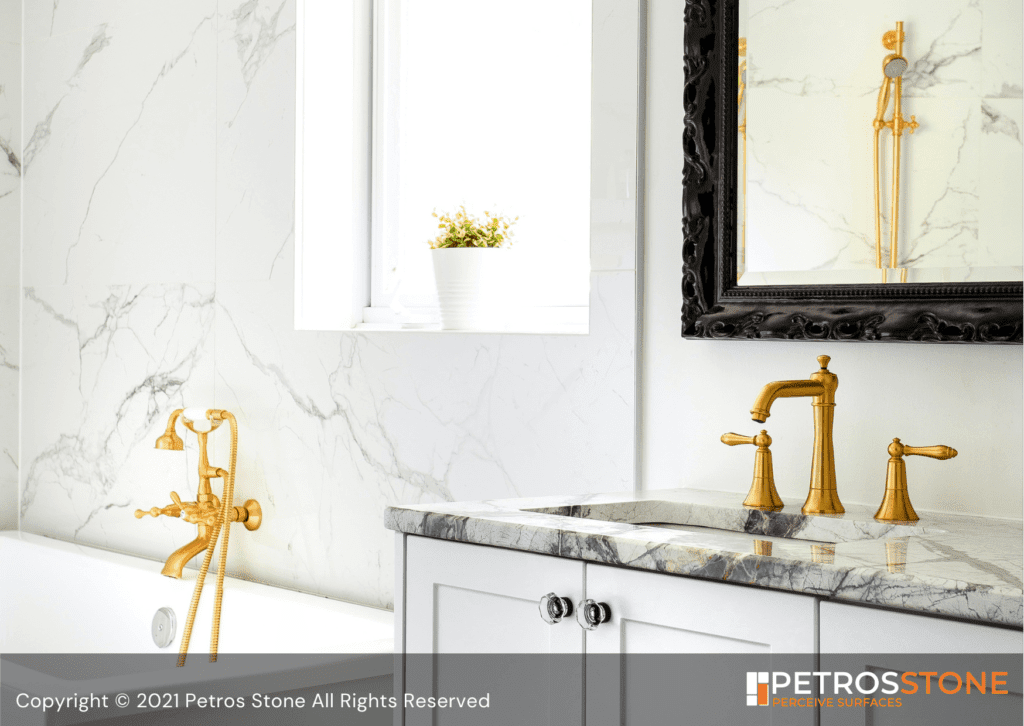
Italian marble, on the other hand, adds a luxurious, ultra-modern look to your home, and can be used pretty much everywhere – flooring, walls, tabletops, decorative features – it is not a common choice for countertops as it is highly prone to staining and moisture.
Costs
Italian marble is a tad bit expensive compared to its Indian counterpart in terms of cost per foot. While Italian marble starts at INR 350 per square foot, its Indian counterpart starts at INR 80 per square foot. The cost of laying both is almost the same, which is around INR 10 to 300 per square foot.
Shortcomings of using Indian and Italian Marble for Interiors
Weight
Marble is a heavy natural stone, heavier than tiles and other types of artificial flooring. The result is that the transportation and installation or even repair of marble becomes much more tedious, and therefore costlier. At the same time, this makes it difficult for you to handle marble slabs on your own, lest you should damage it. An expert is always needed.
Despite its weight, marble is not as durable as Granite or Quartz. Italian marble is incredibly soft, and susceptible to cracks, chips and scratches even without heavy duty use. This means that the weight of marble is strictly unwelcome, for it does not make it super sturdy either.
Porosity
Compared to Quartz or even Granite, Marble is more porous. This is why it gets stained easily. Made of calcium carbonate, which is a salt, marble reacts with acidic substances such as citric juices, which can corrode the surface. This can create several small pits on the marble surface, making Quartz or Granite a more preferred choice for kitchen countertops.
Both Indian and Italian marble present this shortcoming.
High maintenance
Italian marble is a soft stone, which means it is easy to cause scratches or chips when placing heavy or sharp objects on the surface or moving them around on floors. Therefore, one needs to put in extra efforts when using marble for flooring or on kitchen and bathroom countertops.
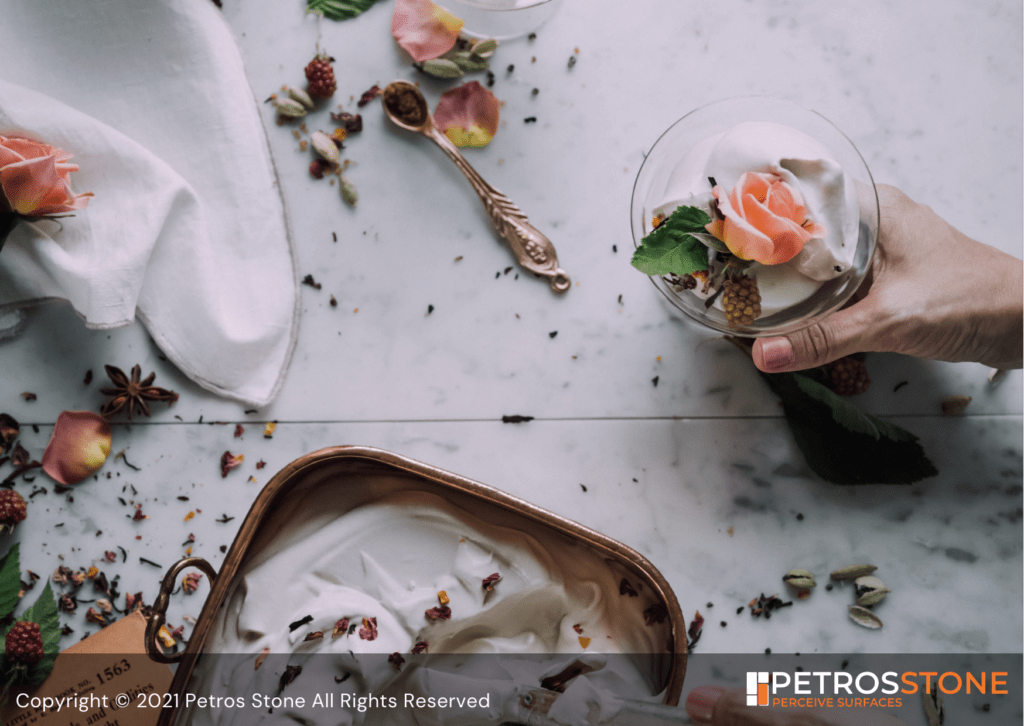
At the same time, marble’s high porosity and chemical reactions make it difficult to use just any random chemical cleaner on its surface. You cannot, however, use only water to clean it either.
Over time, marble, especially the Italian type, can develop hairline cracks due to weight of pressure, or wear away. While some may feel it adds the charm of ageing, others believe that this makes marble a stone that needs high maintenance to keep going.
Need for levelling during installation
If all the marble slabs are not perfectly levelled during installation, they may develop deep cracks over a period of time. This is why it is extremely important to get experts to help you with the installation process.
Costs
Compared to more economical alternatives such as Quartz, Granite or Nano White Crystallised Glass, and even Vitrified Tiles. This makes it the second preference for several homes on a budget, or even large commercial spaces which need bulk material for flooring, etc.
Why Marble Interiors Never go out of Trend
Over the last few years, Marble has made a strong comeback in interior décor. What was once synonymous with classic, retro luxury, has now come to be associated with modern trendy finishes in both interior design and architecture. Despite not being very pocket-friendly, marble continues to remain one of the top choices for designers and owners who want to give their interiors a unique edge.
Marble’s evergreen popularity does not rely solely on its looks though. The gorgeous natural stone comes with impressive technical qualities as well – marble has intense lustre, remains stain-free and is incredibly easy to clean and maintain. Here are some more qualities of marble that add to its avant-garde exquisiteness.
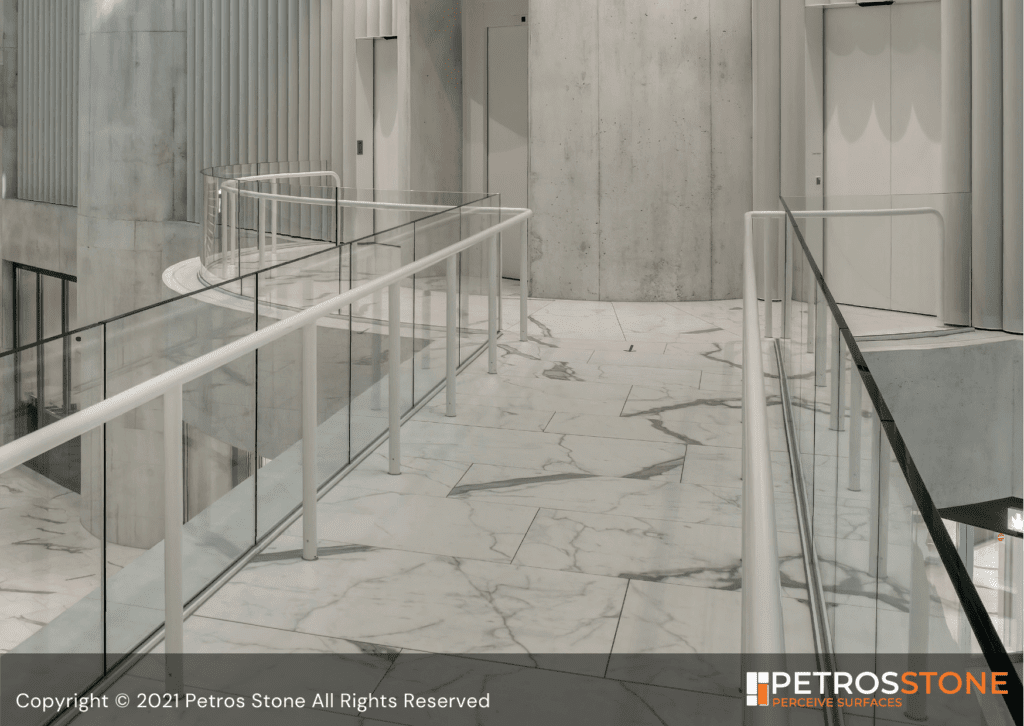
Durability
If treated with care, love and a little vigilance, Marble countertops, floors, and other elements can last for extremely long. Though not considered as sturdy as Granite or Quartz stone surfaces, Marble does come with impressive durability, as evidenced by its use down the centuries. No wonder, several ancient monuments still have elegant Marble floors and sculptures as proof the long life of this natural stone.
Multiple varieties of Marble available with Petros are sufficiently durable for use in kitchens and bathrooms as countertops, backsplashes or wall tiles. More commonly, marble is used as an exquisite flooring option, and can withstand the wear and tear of medium footfall for years.
Eco-friendliness
Many people say that Marble is the perfect epitome of sustainable beauty, and for good measure. Besides the fact that Marble can jazz up your interior like no other, the natural stone is extracted straight from the earth and can be extracted from quarries across the globe. This absence of exclusivity eliminates the need of major transportation.
Large slabs not in use can be cut down to small pieces for backsplashes, which can be upcycled into decor & accessories. At the end of its lifecycle, one can crush Marble into minute pieces and use it in concrete. In short, you may call Marble eternal, and thus eco-friendly.
Unique
Keeping its technical goodness aside, Marble is certainly a sight to behold, and a unique sight each time too. No two Marble slabs can be exactly identical, and the variations in veination, patterns, colours and grains is impressively wide. The best part is that these design variations are completely organic and reflect nature’s beauty at its best.
Trending Ideas to use Marble for Interiors
No matter what the shortcoming, marble continues to be a favourite among designers, architects and owners when it comes to the most elegant interior and exterior choices.
Marble has traditionally been used as the outer facade of several Indian monuments, as for flooring. However, there are many more trending ideas these days for using marble for interiors. Let’s look at a few.
Marble Flooring
Marble floors have been a raging trend for several years now. Prized for its beauty, elegance and style, the natural stone has been a favourite down the years for the most upscale, luxurious floors in residential and commercial establishments alike. Italian marble scores higher when it comes to looks, but Indian marble takes the lead in terms of durability.
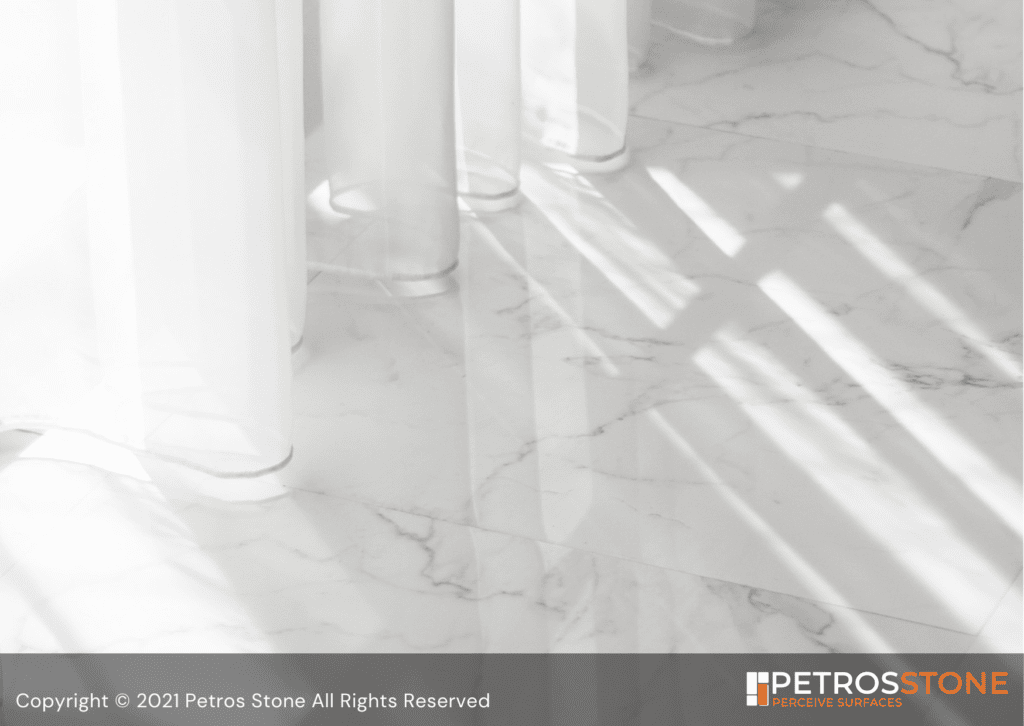
Though marble requires more maintenance and care compared to ceramic tiles or quartz when used as flooring, none can match its natural sheen, complex organic veins and gorgeous colours. Add to that the ease of polishing a marble surface, and marble is easily one of the most preferred modern choices for flooring.
Kitchen and Bathroom Countertops
Marble remains the top choice for several homeowners when it comes to selecting kitchen and bathroom countertops. The natural material offers a handsome variety, besides lovely natural patterns that is tough to beat with artificial materials.

Between Indian vs Italian marble, the Indian variety takes the lead when it comes to the best marble for countertops. This is because Italian marble is comparatively softer and more susceptible to cracks upon placing heavy or sharp objects on it. At the same time, it is more porous and, therefore, gets stained easily.
Accessories & Accents
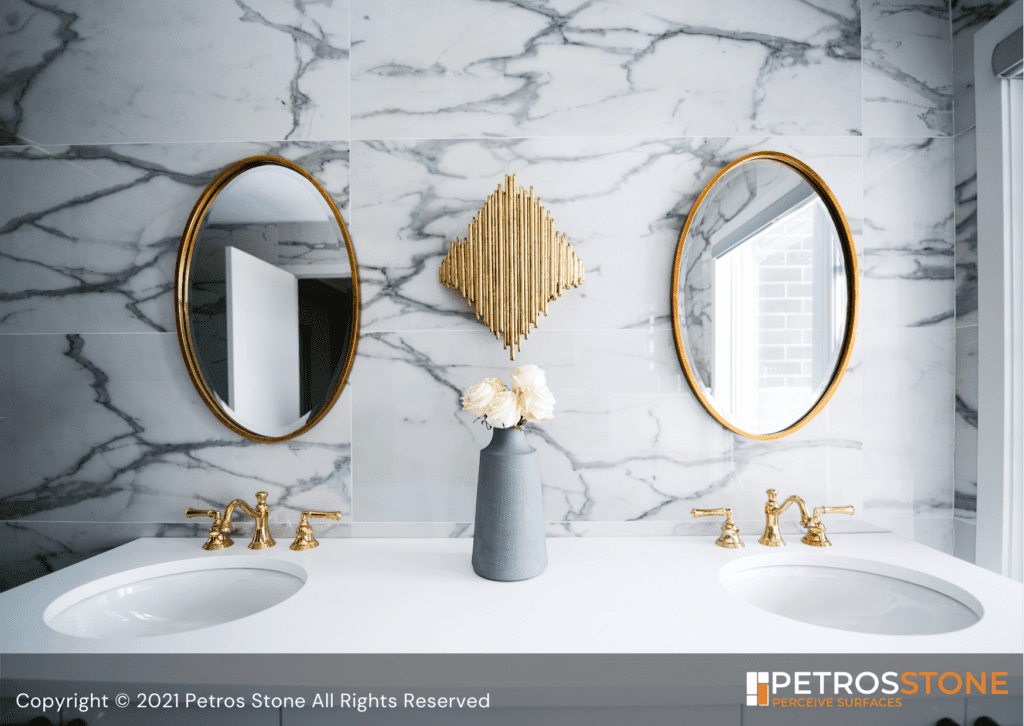
Marble has already made its way into minimalist decor routines, because no material is as versatile as marble when it comes to application. You can use marble wall tiles on an exclusive side of your room where you want to accentuate some interior decor pieces, for instance.
Lighting
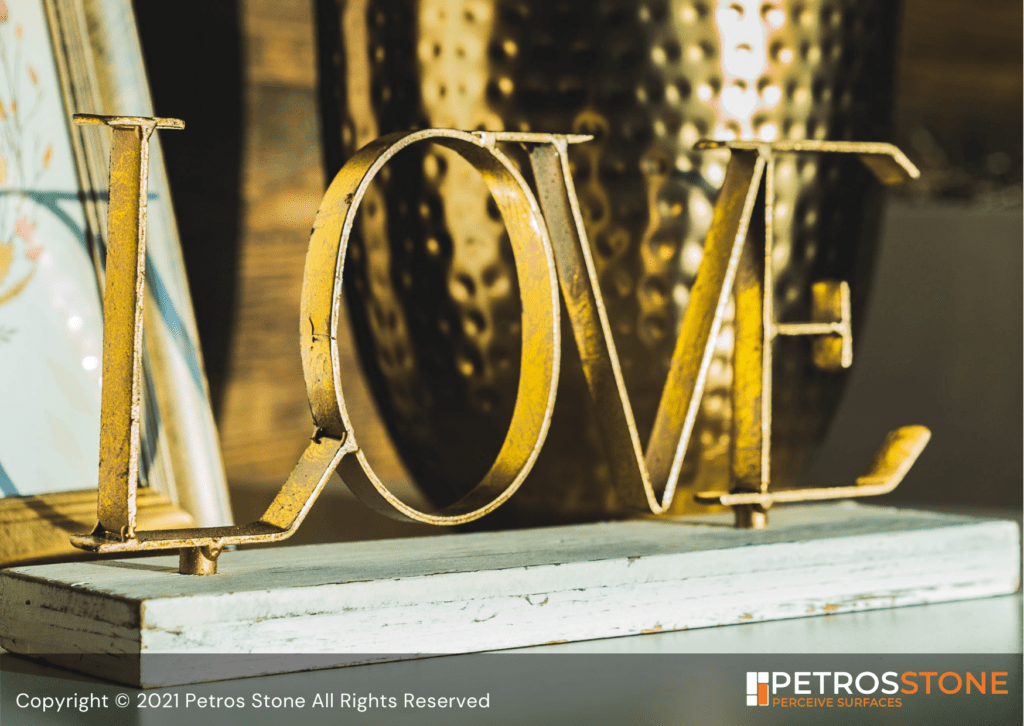
Marble lamps are a very trendy piece of decor these days, with just a slight hint of marble in your favourite rose gold, black or white colours. Available in table lamps, floor lamps, pendants, and other varieties, such marble lighting is a sight to behold.
Shelving
Imagine having marble for your study table as well as shelf! For people who love a dash of softness in their interiors, this could be a great idea. You could simply use cutouts in marble wall panels to store books or have small marble slabs on walls for shelving interesting decor pieces.
Furniture
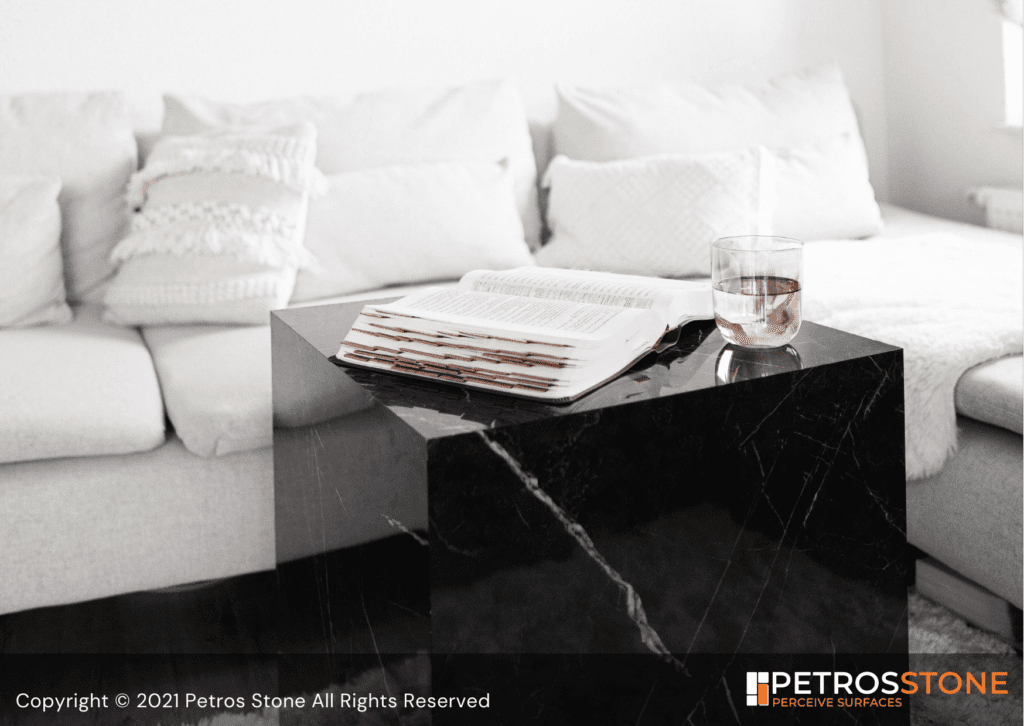
Glamming up your home or office was never this easy – simply add a dash of marble to your furniture! Marble tabletops and coffee tables boast of natural striations that catch the eye instantly. You could think of pairing marble with golden or black frames for an added impact. Italian marble would do a great job here because looks take precedence over hardness.
Sculptures
Accentuate your interiors with small and big marble sculptures in any theme you want to. The softness of marble, especially Italian marble, makes it easier to cut and mould it as you want. Sculptures of the Buddha or the Taj Mahal are a common sight in Indian households, as are sculptures of Hindu deities.
Indian vs Italian Marble: Our Pick?
When it comes down to choosing between Indian vs Italian marble, after a detailed comparison and applications description, it is clear that both are incredible in their own right. However, there are a few key differences to note that may guide your decision ultimately.
In our view, you should prefer Indian Marble when durability and longevity are your priorities, and Italian Marble when you are more focused on the aesthetics than anything else.
Before choosing between Indian vs Italian marble for your space, you must be extremely clear about the space or function you want to use it for. Say, you might not want to use Italian marble for your countertops, but could certainly go for the material as a decorative object for your interior. It might not be the best choice for kitchen countertops, but proves to be a baker’s best friend.
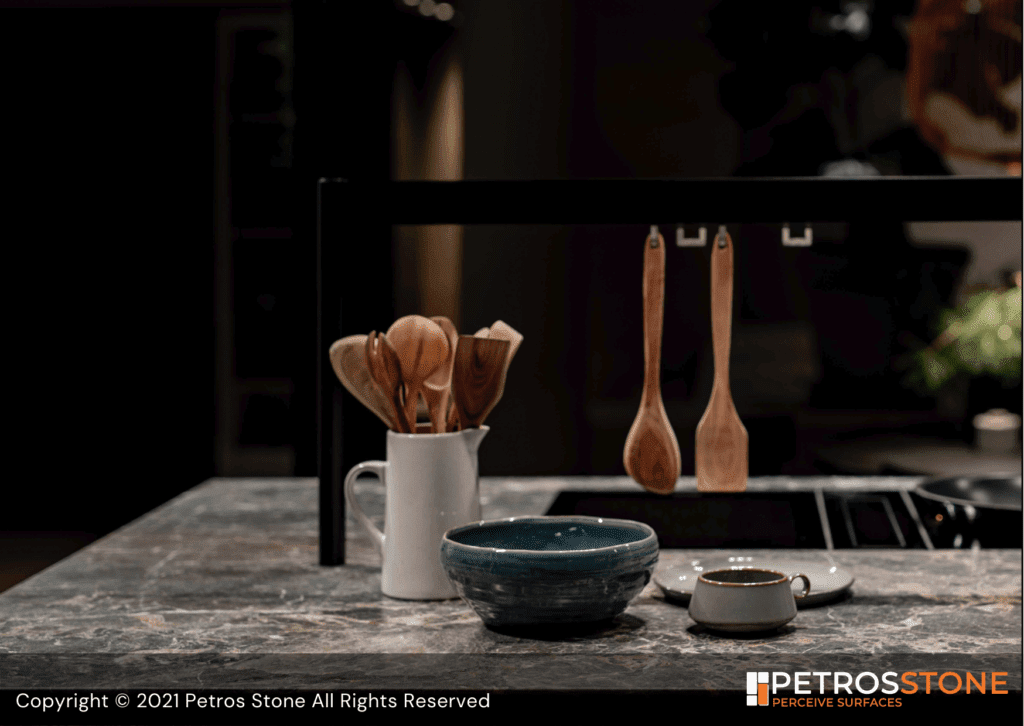
Points to Keep in Mind – Picking between Indian & Italian marble
- Indian Marble is more Durable, hence better suited for flooring in areas of regular use or heavy traffic.
Therefore, your kitchen and living room, or the hallway and staircases of a public building better avoid Italian marble altogether.
- Indian Marble is less porous compared to its Italian counterpart, making it more useful as kitchen and bathroom countertops, as it won’t stain so easily.
Unless you want cleaning and maintenance to become a pain in the neck for you, avoid using Italian marble as kitchen countertops.
- Italian Marble has superior lustre compared to Indian Marble, which offers medium lustre only. Therefore, public establishments or areas with more focus on grandness could use Italian marble.
When it comes down solely to the looks, Italian marble beats all the other choices fair and square. Use this marble variety to show off your preference for regality and sheen, patterns and veins, uniqueness and standards.
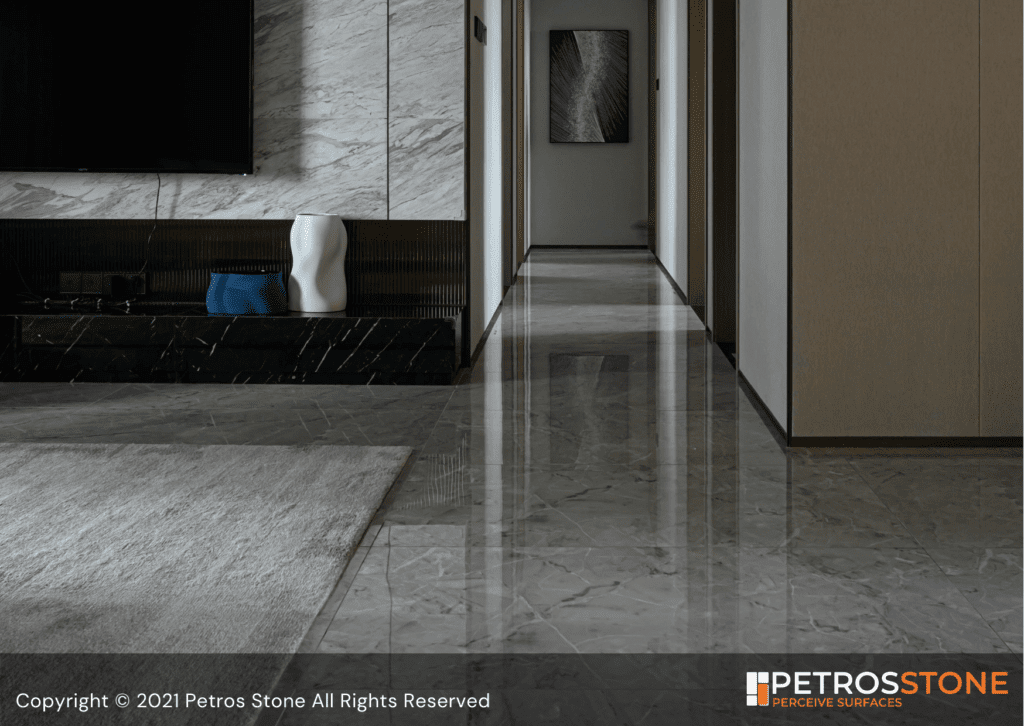
Italian Marble has richer colour and pattern variations, making it the perfect choice when aesthetics are dictating your choice.
There is no dearth of options when it comes to picking the best fit for your interiors from a marble catalogue. Colours, patterns, striations, veinations, density – the more the factors, the more the options. Interestingly, you can just pay a visit to a marble showroom and be mesmerised with the endless options before you to choose from.
The Final Verdict
At the end of the day, both Indian and Italian marble varieties are considered more luxurious and elegant than any other flooring surface options. Both come with a characteristic sheen that is not seen in other natural stone surfaces such as Granite or even better options such as Quartz.
The best alternatives to Indian or Italian marble would be High Grade Petros® Quartz – which combines both – the beauty of Italian Marble and the durability better than that off even granite.
Many people prefer using natural marble for their spaces, as it denotes a unique status symbol due to its luxurious elegance. No wonder, marble is back in trend these days as a preferred flooring material.
Best Place for Indian and Italian Marble
The quality of marble purchased can make or break your look. At the same time, opting for marble slabs of the right brand assures superior quality and durability. Therefore, people would always recommend you to opt for a trusted source when it comes to purchasing expensive stones such as marble.
Petros Stone LLP has been regarded as one of the Largest Stone Brands in India. We help you find the right surfaces for your project, based precisely on the kind of look you want to achieve and the kind of function you will be exposing the surface to.
Our expert team boasts of several years of extensive experience when it comes to supplying superior quality marble slabs, both Indian and Italian. We bring to the table assured quality, high performance and reasonable prices, so that you can make your dreams come true in the beauty of marble. We can help you choose the best from Indian vs Italian marble depending on the functional and aesthetic requirement of your space, while also providing you with end-to-end solutions for transportation up to project location.

Hi, I’m Rishabh Jain, Director – Exports & Marketing at Petros® Stone. With a deep focus on global markets and strategic growth, I’m passionate about taking India’s finest natural stones to the world, combining innovation, quality, and strong relationships to deliver lasting value.




